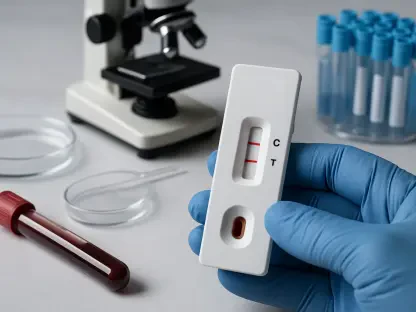Imagine a world where prenatal ultrasounds are so precise that even the tiniest abnormalities in a developing fetus can be detected with near-perfect accuracy, long before they become critical issues, thanks to groundbreaking advancements in technology. This vision is becoming a reality through a pioneering study by researchers Priyadharshni and Ravi, recently published in Scientific Reports. Their innovative approach integrates quantum computing with dynamic graph theory to dramatically enhance fetal plane classification in ultrasound imaging. This breakthrough tackles persistent challenges like noisy data and misclassification, which have plagued traditional methods for years. Fetal plane classification, the process of identifying key anatomical structures such as the brain, heart, and limbs, is vital for early diagnosis and intervention. With quantum technology, the potential to transform prenatal diagnostics is immense, promising better outcomes for mothers and babies. This article delves into how this cutting-edge method is poised to redefine the landscape of maternal-fetal medicine with unprecedented precision and speed.
Unpacking the Struggles of Conventional Ultrasound Methods
Traditional ultrasound imaging, while a cornerstone of prenatal care, often grapples with significant limitations that can compromise diagnostic accuracy. The inherent noise and variability in ultrasound data frequently lead to misclassifications of fetal planes, making it difficult to accurately identify critical anatomical features. These errors can delay the detection of potential abnormalities, posing risks to both maternal and fetal health. Classical computational techniques, which form the backbone of conventional systems, struggle to process the complex and voluminous data generated by modern ultrasound scans. This inadequacy often results in missed or late diagnoses, highlighting the urgent need for a more robust solution. As prenatal care increasingly relies on early and precise identification of issues, the shortcomings of these outdated methods become even more pronounced, pushing the boundaries of what technology must achieve to meet current healthcare demands.
Moreover, the reliance on manual interpretation in many traditional ultrasound systems adds another layer of potential error to an already challenging process. Even with skilled technicians, human judgment can vary, and subtle anomalies may go unnoticed amidst the grainy, ambiguous images typical of standard scans. The time-intensive nature of analyzing such data further exacerbates delays in clinical decision-making. Unlike newer approaches that aim to automate and refine classification, older methods lack the computational power to filter out irrelevant noise or prioritize key features effectively. This gap not only affects the reliability of diagnoses but also places additional strain on healthcare providers who must navigate these limitations under tight schedules. The persistent struggle with data complexity and interpretive inconsistency underscores why a revolutionary shift in ultrasound technology is not just beneficial but necessary for advancing prenatal diagnostics to a higher standard of care.
Harnessing Quantum Computing for Unmatched Processing Power
Quantum computing represents a seismic shift in how complex data, such as that from fetal ultrasounds, can be processed with extraordinary efficiency. Unlike classical computing, which processes information in a linear fashion, quantum technology leverages a principle known as quantum parallelism to explore multiple solutions simultaneously. In the context of Priyadharshni and Ravi’s research, this capability is harnessed for feature selection, allowing the system to sift through vast amounts of ultrasound data and identify the most relevant elements at an unprecedented pace. This rapid processing is a game-changer for fetal plane classification, where pinpointing critical anatomical structures swiftly can make all the difference in early diagnosis. The ability to handle intricate datasets without sacrificing precision marks a significant departure from the sluggish, error-prone methods of the past, setting a new benchmark for medical imaging technology.
Beyond sheer speed, quantum computing offers a level of analytical depth that traditional systems simply cannot match. By evaluating numerous data pathways at once, it ensures that no critical feature in an ultrasound scan is overlooked, even amidst noisy or incomplete information. This robustness is particularly vital in prenatal imaging, where the stakes are high, and overlooking a small detail could have serious consequences. The researchers’ method optimizes the selection of data points that contribute most to accurate classification, effectively cutting through the clutter that often obscures vital insights in standard scans. This precision not only enhances diagnostic reliability but also reduces the computational burden, freeing up resources for other clinical needs. As quantum technology continues to evolve, its integration into medical diagnostics promises to push the boundaries of what’s possible, offering a glimpse into a future where delays and inaccuracies in fetal imaging are relics of a bygone era.
Adapting to Data with Dynamic Graph Theory
A pivotal element of the groundbreaking approach by Priyadharshni and Ravi lies in the application of dynamic graph theory, which introduces an adaptive framework to fetal ultrasound analysis. This methodology constructs a graph based on initial features extracted from ultrasound images, but unlike static models, this graph evolves over multiple iterations. As it refines connections between data points, the system becomes increasingly adept at recognizing patterns specific to fetal planes, such as those representing the heart or brain. This adaptability ensures that the technology remains responsive to the unique characteristics of each scan, overcoming the rigidity of traditional methods that often fail to account for variability. The result is a marked improvement in classification accuracy, providing clinicians with clearer, more reliable information to guide their assessments during critical prenatal evaluations.
The dynamic nature of this graph-based system also addresses one of the most persistent challenges in ultrasound imaging: the sheer diversity of data encountered across different patients and conditions. By continuously updating its structure to prioritize the most relevant features, the graph minimizes the impact of irrelevant noise that typically muddles conventional analyses. This iterative refinement process allows for a deeper understanding of complex anatomical relationships within the fetus, enhancing the system’s ability to distinguish between normal and abnormal structures. Such precision is invaluable in a field where every detail matters, and misinterpretation can lead to significant oversight. Furthermore, the integration of this adaptive technology with quantum computing amplifies its effectiveness, creating a synergy that tackles both the computational and interpretive hurdles of fetal imaging. This innovative pairing sets a new standard for how medical data can be visualized and understood in real-time clinical environments.
Elevating Diagnostic Efficiency and Precision
One of the most transformative aspects of combining quantum computing with dynamic graph theory is the dramatic boost in both diagnostic speed and precision for fetal ultrasounds. The quantum-driven feature selection cuts through the complexity of ultrasound data at lightning speed, identifying key elements essential for accurate plane classification without the lag associated with older systems. Meanwhile, the dynamic graph adapts to refine these selections, ensuring that the output is not only fast but also exceptionally reliable. This dual advantage translates directly to clinical settings, where quicker processing means faster diagnoses, enabling healthcare providers to address potential issues in pregnancy with minimal delay. In scenarios where time is of the essence, such as detecting life-threatening abnormalities, this efficiency can be the difference between timely intervention and critical oversight.
Additionally, the reduction in computational load offered by this approach cannot be understated, as it streamlines the entire diagnostic workflow without compromising on quality. Traditional methods often require extensive resources to process large datasets, leading to bottlenecks that hinder clinical efficiency. In contrast, the optimized processing enabled by quantum and graph-based techniques frees up valuable time and technological capacity, allowing medical teams to focus on patient care rather than waiting on results. This improvement in turnaround time enhances the overall patient experience, reducing anxiety for expectant parents awaiting critical information. Moreover, the heightened accuracy minimizes the risk of false positives or negatives, fostering greater trust in ultrasound outcomes among both clinicians and families. As this technology gains traction, it holds the potential to become a cornerstone of prenatal diagnostics, ensuring that speed and precision work hand in hand to safeguard maternal and fetal well-being.
Redefining Prenatal Care Through Clinical Innovation
The clinical implications of this quantum-enhanced ultrasound technology are nothing short of revolutionary for prenatal care. By significantly reducing diagnostic errors in fetal plane classification, the method developed by Priyadharshni and Ravi ensures that abnormalities are identified much earlier in pregnancy. Early detection is crucial, as it allows healthcare providers to implement interventions promptly, potentially preventing severe complications for both mother and child. This advancement transforms routine ultrasound screenings from a process fraught with uncertainty into a reliable tool that clinicians can depend on for critical decision-making. The promise of improved outcomes—fewer missed diagnoses and more proactive care—marks a substantial leap forward in how prenatal health challenges are addressed, offering renewed hope to countless families navigating the uncertainties of pregnancy.
Beyond immediate diagnostic benefits, this technology paves the way for a broader reimagining of maternal-fetal medicine as a field driven by precision and innovation. The ability to trust ultrasound results with greater confidence empowers medical professionals to tailor care plans more effectively, addressing individual needs with a level of specificity that was previously unattainable. This shift also has the potential to reduce the emotional and financial burden on families by minimizing unnecessary follow-up tests or delayed treatments due to inaccurate initial scans. As the method proves its efficacy, it could set a precedent for integrating advanced computational tools into everyday healthcare practices, ensuring that prenatal care keeps pace with technological progress. The ripple effects of such a transformation extend far beyond individual patients, promising to elevate standards of care across entire communities and healthcare systems worldwide.
Navigating Future Hurdles and Expanding Horizons
While the initial results of this quantum-driven approach to fetal ultrasound imaging are undeniably promising, several challenges remain on the path to widespread clinical adoption. The complexity of quantum technology necessitates extensive further testing to ensure its reliability and safety across diverse patient populations. Additionally, healthcare facilities must invest in infrastructure upgrades to support such advanced systems, a process that could take significant time and resources. Training medical professionals to operate and interpret results from this cutting-edge technology is another critical hurdle, as unfamiliarity could undermine its potential benefits. Despite these obstacles, the researchers remain committed to refining their method through rigorous validation, emphasizing the importance of addressing any limitations before full integration into routine practice.
Looking to the future, the opportunities presented by this technology extend well beyond fetal imaging, opening doors to applications in other medical fields like oncology or cardiology where precision and speed are equally vital. The principles of dynamic graph-based quantum feature selection could be adapted to tackle a range of complex datasets, potentially revolutionizing diagnostics on a global scale. Collaboration across disciplines—between quantum physicists, computational experts, and medical practitioners—will be essential to realize this broader vision. Priyadharshni and Ravi advocate for such partnerships, recognizing that collective effort is key to overcoming technical and logistical barriers. As research progresses, the focus must remain on ensuring equitable access to these advancements, so that cutting-edge care becomes a reality for all, not just a privileged few. This forward-thinking approach underscores the transformative potential of merging quantum innovation with healthcare needs.
Reflecting on a Milestone in Medical Progress
Looking back, the journey of integrating quantum technology into fetal ultrasound imaging, as spearheaded by Priyadharshni and Ravi, stands as a defining moment in prenatal diagnostics. Their method, blending quantum computing with dynamic graph theory, tackled the persistent issues of data noise and misclassification with remarkable success, achieving levels of accuracy and speed that were once thought unattainable. The clinical impact is evident in the enhanced ability to detect fetal abnormalities early, which allows for timely interventions that save countless lives. Collaborative efforts and rigorous testing played a crucial role in refining this approach, ensuring it meets the highest standards of safety and reliability. As a beacon of interdisciplinary achievement, this work not only reshapes ultrasound practices but also inspires future innovations in medical technology. Moving forward, the focus should shift to scaling these advancements, ensuring that healthcare systems worldwide adopt and adapt such technologies to continue improving maternal and fetal outcomes.









